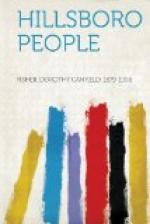And now he was gone, the last of the race. His disappearance caused the usual amount of reminiscent talk among his neighbors. The older people recalled the bygone scandals connected with his notorious and popular father and intimated with knowing nods that there were plenty of other descendants of the old Governor who were not entitled legally to bear the name; but the younger ones, who had known only the severely ascetic life and cold personality of the celebrated scholar, found it difficult to connect him with such a father. In their talk they brought to mind the man himself, his quiet shabby clothes, his big stooping frame, his sad black eyes absent almost to vacancy as though always fixed on high and distant thoughts; and those who had lived near him told laughing stories about the crude and countrified simplicity of his old aunt’s housekeeping—it was said that the president of Harvard had been invited to join them once in a Sunday evening meal of crackers and milk—but the general tenor of feeling was, as it had been during his life, of pride in his great fame and in the celebrated people who had come to see him.
This pride warmed into something like affection when the day after his death, came the tidings that he had bequeathed to his college the Gino Sprague Falleres portrait of himself. Of course, at that time, no one in Middletown had seen the picture, for the philosopher’s sudden death had occurred, very dramatically, actually during the last sitting. He had, in fact, had barely one glimpse of it himself, as, according to Falleres’s invariable rule no one, not even the subject of the portrait, had been allowed to examine an unfinished piece of work. But though Middletown had no first-hand knowledge of the picture, there could be no doubt about the value of the canvas. As soon as it was put on exhibition in London, from every art-critic in the three nations who claimed Falleres for their own there rose a wail that this masterpiece was to be buried in an unknown college in an obscure village in barbarous America. It was confidently stated that it would be saved from such an unfitting resting-place by strong action on the part of an International Committee of Artists; but Middletown, though startled by its own good fortune, clung with Yankee tenacity to its rights. Raphael Collin, of Paris, commenting on this in the Revue des Deux Mondes, cried out whimsically upon the woes of an art-critic’s life, “as if there were not already enough wearisome pilgrimages necessary to remote and uncomfortable places with jaw-breaking names, which must nevertheless be visited for the sake of a single picture!” And a burlesque resolution to carry off the picture by force was adopted at the dinner in London given in honor of Falleres the evening before he set off for America to attend the dedicatory exercises with which Middletown planned to install its new treasure.




